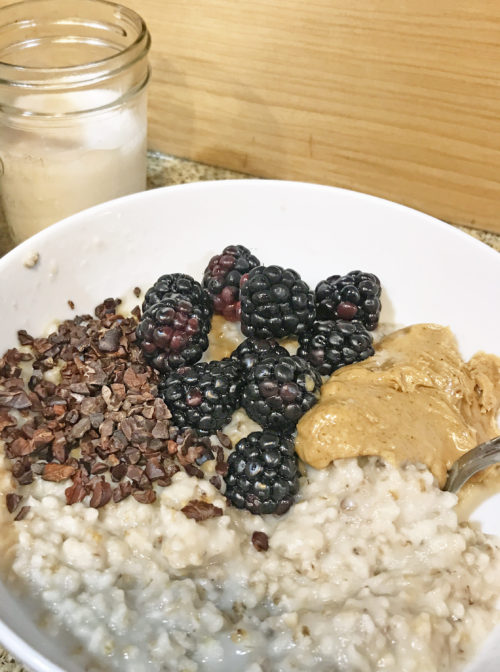
Steel cut oats are a great complex carbohydrate. The is my steel cut oats meal prep recipe. Make ahead and enjoy for breakfast or a snack throughout the week.
Why Eat Oatmeal? Fiber!
The obesity rates in America are continuing to rise. It’s no surprise that we consume half the American Heart Association’s recommended 28 grams per day, clocking in at just 15 grams for women.
Oatmeal is a great source of soluble and insoluble fiber. Fiber keeps you fuller longer, leading to less calories consumed throughout your day. Eating more fiber adds up over time and may lead to weight loss without even trying.
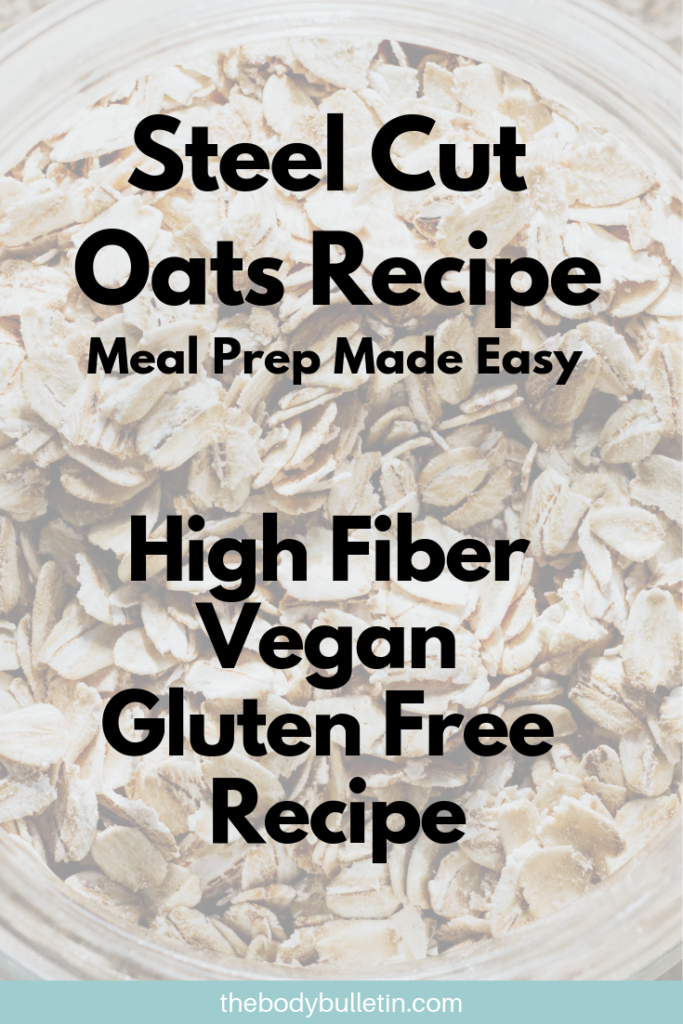
Studies have shown increased dietary fiber intake have resulted in lower body weight in rats. More studies are needed on humans as evidence remains equivocal. However, a key component to these studies should be noted. Studies with subjects (animals) that remain in a lab, allow for full control on diets. Whereas, studies on humans lack control on human dietary fiber intake. This is due to humans not living in the laboratory.
Those pesky humans, eating as they wish…
How Are Oats Processed?
All oats start out as “oat groats” prior to being processed into the many forms by which we consume them.
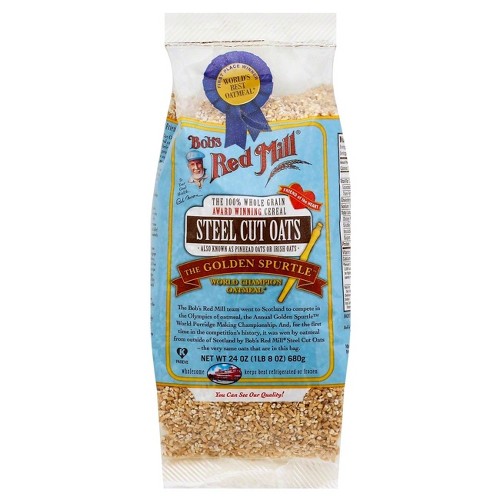
Steel cut oats are oat groats that are chopped 2 or 3 times via steel blade (hence the name). These are the least processed of all the readily available oat forms.
Rolled oats go through a lengthy process of steaming the groats, rolling them, steaming again, until finally toasting them, which results in the long oval flakes you’ve come to know. Rolled oats are most often used in baking.
Instant and quick oats go through further processing to make them smaller so they will cook faster. In the same vein, this often leads them to be more “mushy” once cooked.
Glycemic Index (GI)
GI ranks carbohydrate foods on how fast they affect blood sugar (glucose). While the research was varied, the chart below displays the range of GI of oats.
| Oat Type | Glycemic Index Range |
| Steel Cut/Rolled | 53 – 65 |
| Instant/Quick | 70 – 85 |
The processing of oat groats into instant or quick oats allows them to cook faster, but has the negative effect of faster digestion. Furthermore, this creates an increase in blood sugars (glucose) and in the glycemic index of the more processed versions. Essentially, your body does less work to digest the more processed oat versions.
Steel cut oats most closely retain their original form (groats) just prior to being cooked and eaten. The research is limited on the differences in how our body processes steel cut oats and it’s steamed and milled counterparts. However, based on glycemic load, the more the body has to work to digest and break down food, the slower the food will process.
Slowing the digestive process down results in a lower glycemic index. This is caused by the digestive enzymes taking a longer time to break down the food we eat. Carbs that have the highest GI break down the fastest, creating a spike of our blood sugars.
So Which One Is The Best To Eat?
Download the list – 17 High-Fiber Complex Carbohydrates
Be careful with misleading nutrition labels. When comparing a food that comes in different forms, such as oats, equal weight is the only way to precisely compare.
I broke down the nutrition information below based on weight, rather than a half cup measurement like most labels. Consequently, by looking at nutritional value by weight you get an accurate comparison based on density of that food.
Below chart based on 52 grams of oats:
| Oat Type | Fiber | Protein | Carbs | Calories |
| Steel Cut | 4.72g | 7g | 36g | 200 |
| Rolled/Old Fashioned | 5.2g | 6.72g | 35g | 195 |
| Quick/Instant | 5g | 7g | 36g | 200 |
All forms of oats generally have the same nutritional amounts, so does it really matter which one you eat?
The differences usually come in subtle ways. More often than not instant and quick oats will have additives that can add sodium, sugar or other preservatives. Just take a look at a common brand’s ingredients for their instant oatmeal packets:
WHOLE GRAIN ROLLED OATS, CALCIUM CARBONATE, SALT, GUAR GUM, CARAMEL COLOR, REDUCED IRON, VITAMIN A PALMITATE
In general, it’s safe to assume the least processed foods are better for us. The fact that the steel cut version of oats are the least processed of all the varieties leads me to my own conclusion they are the best, and in my humble opinion, taste the best.
Okay, so you know I prefer steel cut oats at this point. But how do you prepare these minimally processed whole grains?
How To Cook Steel Cut Oats
Cooking steel cut oats is more time and labor intensive but the flavor and texture is beyond worth it if you ask me. This is also a great make ahead recipe for meal prep as the oats will last in the fridge for several days.
Sugar-Free, Vegan, Gluten-Free Steel Cut Oats Recipe
Time:
- 5 minutes to prep
- 31 minutes to cook
- 36 minutes total
Ingredients:
- 1 tbsp coconut oil
- 1 cup dry steel cut oats
- 3 cups water
- 1 cup unsweetened coconut milk or canned coconut milk or other milk option
- Pinch of kosher salt
- Optional: Cinnamon, nutmeg
Directions:
- Boil 3 cups of water in a separate saucer or place water in an electric kettle and heat to boiling.
- Heat large saucer on medium low, melt coconut oil about 1 minute.
- Add steel cut oats to oil in saucer, stir regularly until lightly toasted. (I almost always end up burning it, so watch closely!)
- Once oats are toasted light brown, reduce heat to low, add 3 cups of boiling water and 1 cup of coconut milk. (If using a sweeter recipe unsweetened vanilla coconut or almond milk will work great).
- Reduce to level 1-2/simmer and cover for 20 minutes, stir regularly (every 3-5 minutes).
- After 20 minutes uncover, stir every 5 minutes for 10 minutes.
- Serve with optional toppings.
Nutritional Information:
The information shown is an estimate provided by an online nutrition calculator. It should not be considered a substitute for a professional nutritionist’s advice.

High Fiber Toppings:
- Cacao nibs 1 grams fiber per tsp (that’s a lot)
- Unsweetened cacao powder 4 grams per 2 Tbsp
- Coconut flakes 2 grams fiber per 2 Tbsp
- Peanut butter 3 grams fiber per 2 Tbsp
- Almond Butter 4 grams fiber per 2 Tbsp
- Strawberries 2 grams fiber per 8 medium berries
- Raspberries 4 grams fiber per ½ cup berries
- Blackberries 4 grams fiber per ½ cup berries
- Fiber cereal 6.5 grams fiber per ⅓ cup
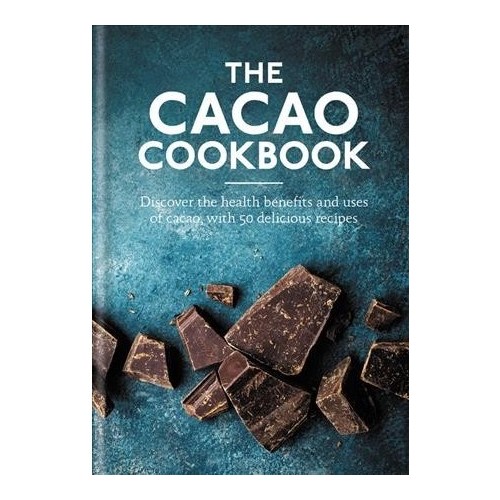
Disclaimer: All opinions are my own. This post is intended for educational, inspirational, or entertainment purposes only. I am not a doctor, the content on this blog is not intended to be substituted for medical advice.







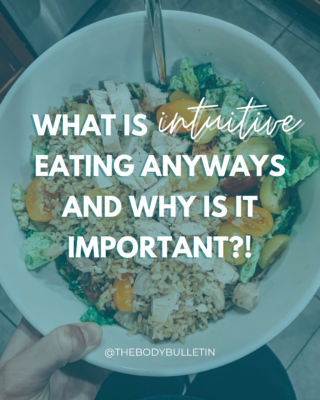

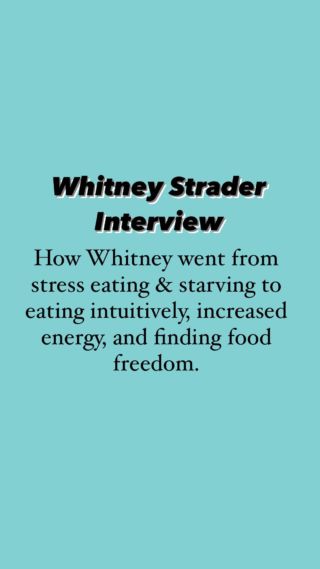
Leave a Reply